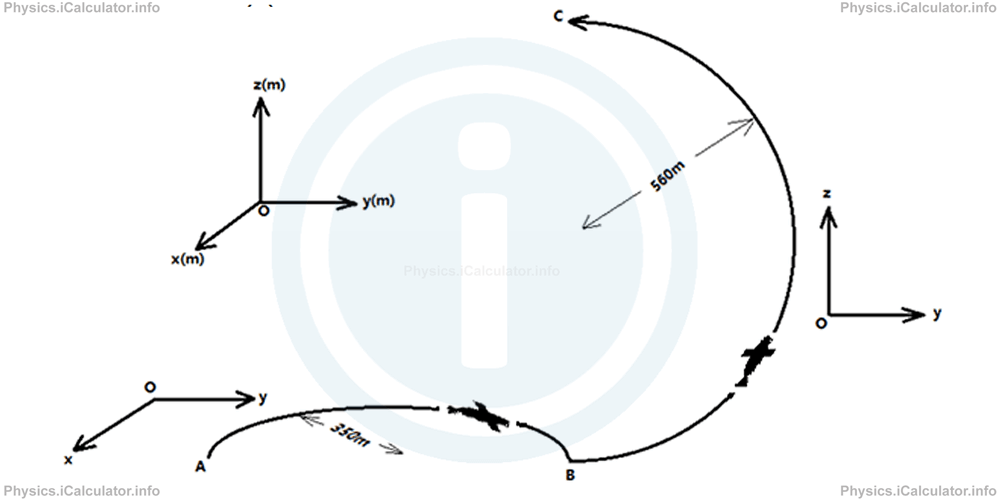Menu
Physics Lesson 3.6.3 - Speed and Velocity in Three Dimensions
Please provide a rating, it takes seconds and helps us to keep this resource free for all to use
Welcome to our Physics lesson on Speed and Velocity in Three Dimensions, this is the third lesson of our suite of physics lessons covering the topic of Speed and Velocity in 2 and 3 Dimensions, you can find links to the other lessons within this tutorial and access additional physics learning resources below this lesson.
Speed and Velocity in Three Dimensions
Everything discussed for Speed and Velocity in two dimensions is also true for these quantities in three dimensions. We have only to add a new dimension (coordinate) z in the calculations. Let's see an example.
Example 2
Calculate the average speed and average velocity for the airplane shown in the figure if both trajectories AB and BC are half circles. The radius of AB is 350 m and that of BC is 560 m. The flight AB is done according the horizontal plane xOy and the flight BC according the vertical plane yOz. Take π = 22/7. The total time of flight is 10 s.

Solution 2
First, let's start with the average speed. We write as R1 the radius of the arc AB and R2 that of the arc BC. Thus, for the arc AB we have
= 1/2 × 2πR1
= πR
= 22/7 × 350 m
= 1100 m
For the arc BC we have:
= 1/2 × 2πR2
= πR2
= 22/7 × 560 m
= 1760 m
Therefore, the total distance travelled by the airplane, is:
= 1100 m+1760 m
= 2860 m
Hence, the average speed of the airplane during the entire motion is
= 2860m/10s
= 286 m/s
As for the displacement, we can see from the figure that we have two displacements combined together. The first is the displacement AB⃗, which lies according the Oy-direction only, although the arc AB lies in the plane xOy. This is because we are interested only in the diameter AB of the first half-circle, which represents the shortest path (the displacement) from A to B.
The same thing can be said for the displacement BC as well, only that the displacement vector BC⃗ lies in the Oz-direction, despite the fact that the arc BC lies in the yOz plane.
Hence, combining the findings above, it is obvious the total displacement vector AC⃗ lies in the yOz plane and it represents the hypotenuse AC of the right triangle ABC where AB and BC are its legs.
Mathematically, we have:
= 2 × r1
= 2 × 350 m
= 700 m
and
= 2 × r2
= 2 × 560 m
= 1120 m
Therefore, the magnitude of the total displacement |∆r⃗| = |AC⃗| is
= √(700 m)2+(1120 m)2
= √490,000 m2+1,254,000 m2
= √1,744,400 m2
≈1321 m
Hence, the average velocity of the airplane during the entire motion is
= 1321m/10s
= 132.1 m/s
≈ 132 m/s
(The result is rounded up to the nearest whole number in order to write it with the correct number of significant figures (see the Physics tutorial Significant Figures and Their Importance).
Remark! In all situations discussed so far, we have assumed the motion to be either uniform (i.e. at the same speed) or it was "modulated" in such a way that the average values of distance, displacement, speed and velocity replaced the actual values. In this way, the calculations became easier and shorter.
You have reach the end of Physics lesson 3.6.3 Speed and Velocity in Three Dimensions. There are 3 lessons in this physics tutorial covering Speed and Velocity in 2 and 3 Dimensions, you can access all the lessons from this tutorial below.
More Speed and Velocity in 2 and 3 Dimensions Lessons and Learning Resources
Whats next?
Enjoy the "Speed and Velocity in Three Dimensions" physics lesson? People who liked the "Speed and Velocity in 2 and 3 Dimensions lesson found the following resources useful:
- Three Dimensions Feedback. Helps other - Leave a rating for this three dimensions (see below)
- Kinematics Physics tutorial: Speed and Velocity in 2 and 3 Dimensions. Read the Speed and Velocity in 2 and 3 Dimensions physics tutorial and build your physics knowledge of Kinematics
- Kinematics Revision Notes: Speed and Velocity in 2 and 3 Dimensions. Print the notes so you can revise the key points covered in the physics tutorial for Speed and Velocity in 2 and 3 Dimensions
- Kinematics Practice Questions: Speed and Velocity in 2 and 3 Dimensions. Test and improve your knowledge of Speed and Velocity in 2 and 3 Dimensions with example questins and answers
- Check your calculations for Kinematics questions with our excellent Kinematics calculators which contain full equations and calculations clearly displayed line by line. See the Kinematics Calculators by iCalculator™ below.
- Continuing learning kinematics - read our next physics tutorial: The Meaning of Acceleration. Constant and Non-Constant Acceleration. Gravitational Acceleration
Help others Learning Physics just like you
Please provide a rating, it takes seconds and helps us to keep this resource free for all to use
We hope you found this Physics lesson "Speed and Velocity in 2 and 3 Dimensions" useful. If you did it would be great if you could spare the time to rate this physics lesson (simply click on the number of stars that match your assessment of this physics learning aide) and/or share on social media, this helps us identify popular tutorials and calculators and expand our free learning resources to support our users around the world have free access to expand their knowledge of physics and other disciplines.